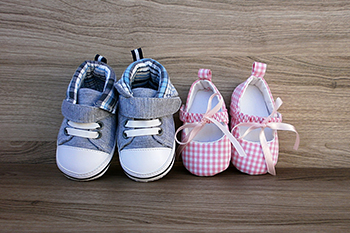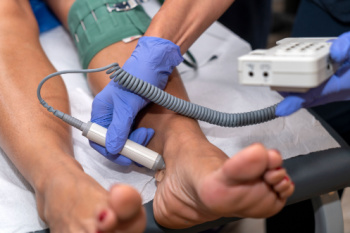Connect With Us
Blog
Items filtered by date: June 2024
How to Prevent Sock Blisters

Preventing sock blisters involves considering several key factors. Choosing the right sock material is vital, as synthetic blends or merino wool are excellent options because they wick moisture away from the skin and reduce friction. Cotton socks, on the other hand, tend to retain moisture, increasing the risk of blisters. Ensuring the correct sock size is also essential. Socks that are too tight can cause pressure points, while those that are too loose can create folds that rub against the skin. Additionally, the construction of the sock matters, as seamless socks or those with flat seams minimize irritation. Padded socks can provide extra cushioning and protection in high-friction areas. Paying attention to these details can significantly reduce the likelihood of developing painful sock blisters during activities. If you have developed blisters that have become infected, and would like to know if the socks or shoes are causing them, it is suggested that you consult a podiatrist who can offer correct treatment and prevention strategies.
Blisters are prone to making everyday activities extremely uncomfortable. If your feet are hurting, contact William Beaton, DPM of Advanced Podiatry and Wound Care. Our doctor can provide the care you need to keep you pain-free and on your feet.
Foot Blisters
Foot blisters develop as a result of constantly wearing tight or ill-fitting footwear. This happens due to the constant rubbing from the shoe, which can often lead to pain.
What Are Foot Blisters?
A foot blister is a small fluid-filled pocket that forms on the upper-most layer of the skin. Blisters are filled with clear fluid and can lead to blood drainage or pus if the area becomes infected.
How Do Blisters Form?
Blisters on the feet are often the result of constant friction of skin and material, usually by shoe rubbing. Walking in sandals, boots, or shoes that don’t fit properly for long periods of time can result in a blister. Having consistent foot moisture and humidity can easily lead to blister formation.
Prevention & Treatment
It is important to properly care for the affected area in order to prevent infection and ease the pain. Do not lance the blister and use a Band-Aid to provide pain relief. Also, be sure to keep your feet dry and wear proper fitting shoes. If you see blood or pus in a blister, seek assistance from a podiatrist.
If you have any questions, please feel free to contact our office located in St. Petersburg, FL . We offer the newest diagnostic and treatment technologies for all your foot care needs.
Babies First Shoes

Selecting the first shoes for babies is an important decision, as it impacts their comfort and foot development. Opt for soft, flexible shoes made from breathable materials like leather or cloth, allowing natural movement and airflow. These materials provide gentle support without restricting the foot's growth. Look for shoes with a roomy toe box to accommodate the baby's developing toes and allow wiggle room. Flexible soles with good traction help prevent slipping while allowing for natural foot movement. Additionally, avoid shoes with stiff soles or tight, rigid structures, as they can hinder proper foot development and cause discomfort. Velcro or elastic closures ensure a snug fit without being too restrictive, making it easier to put on and take off. If you notice anything unusual about your child’s feet, it is suggested that you consult a podiatrist who can provide a comprehensive exam and address any questions you may have about appropriate footwear.
Making sure that your children maintain good foot health is very important as they grow. If you have any questions, contact William Beaton, DPM of Advanced Podiatry and Wound Care. Our doctor can provide the care you need to keep you pain-free and on your feet.
Keeping Children's Feet Healthy
Having healthy feet during childhood can help prevent medical problems later in life, namely in the back and legs. As children grow, their feet require different types of care. Here are some things to consider...
Although babies do not walk yet, it is still very important to take care of their feet.
Avoid putting tight shoes or socks on his or her feet.
Allow the baby to stretch and kick his or her feet to feel comfortable.
As a toddler, kids are now on the move and begin to develop differently. At this age, toddlers are getting a feel for walking, so don’t be alarmed if your toddler is unsteady or ‘walks funny’.
As your child gets older, it is important to teach them how to take care of their feet.
Show them proper hygiene to prevent infections such as fungus.
Be watchful for any pain or injury.
Have all injuries checked by a doctor as soon as possible.
Comfortable, protective shoes should always be worn, especially at play.
If you have any questions please feel free to contact our office located in St. Petersburg, FL . We offer the newest diagnostic and treatment technologies for all your foot and ankle needs.
Vascular Testing for Peripheral Artery Disease

Peripheral artery disease, or PAD, can significantly impact your quality of life by reducing blood flow to your legs and feet. Podiatrists play an important role in detecting and managing PAD through various non-invasive tests. Included are checking the pulse in your feet, using a handheld device to listen to the blood flow, and measuring blood pressure in your ankles and toes. Regular vascular assessments are essential, as early detection of PAD can prevent serious complications like sores or infections that heal poorly. If you experience leg pain while walking, numbness, or slow-healing wounds on your feet, it is important to visit a podiatrist because these symptoms are indicators of peripheral artery disease. A podiatrist can conduct these simple yet effective tests to determine if PAD is affecting you and recommend appropriate treatments or lifestyle changes. Ensuring that your podiatrist performs comprehensive vascular assessments can make a significant difference in managing your condition and improving your overall health. If you are experiencing symptoms of peripheral artery disease, it is suggested that you schedule an appointment with a podiatrist for testing and suggested treatment options.
Vascular testing plays an important part in diagnosing disease like peripheral artery disease. If you have symptoms of peripheral artery disease, or diabetes, consult with William Beaton, DPM from Advanced Podiatry and Wound Care. Our doctor will assess your condition and provide you with quality foot and ankle treatment.
What Is Vascular Testing?
Vascular testing checks for how well blood circulation is in the veins and arteries. This is most often done to determine and treat a patient for peripheral artery disease (PAD), stroke, and aneurysms. Podiatrists utilize vascular testing when a patient has symptoms of PAD or if they believe they might. If a patient has diabetes, a podiatrist may determine a vascular test to be prudent to check for poor blood circulation.
How Is it Conducted?
Most forms of vascular testing are non-invasive. Podiatrists will first conduct a visual inspection for any wounds, discoloration, and any abnormal signs prior to a vascular test.
The most common tests include:
- Ankle-Brachial Index (ABI) examination
- Doppler examination
- Pedal pulses
These tests are safe, painless, and easy to do. Once finished, the podiatrist can then provide a diagnosis and the best course for treatment.
If you have any questions, please feel free to contact our office located in St. Petersburg, FL . We offer the newest diagnostic and treatment technologies for all your foot care needs.
